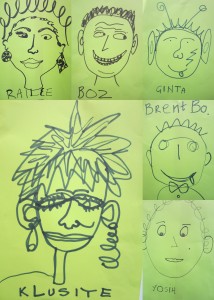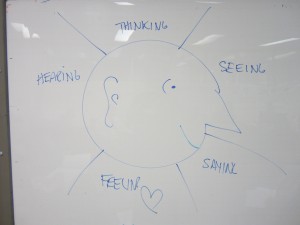Phew! I’ve run workshops in 7 Australian TAFEs in Victoria and Tasmania states in the past three weeks – 3 hours of “intro” in the morning and 3 hours for “advanced” practitioners in the afternoon. Time to debrief!
I had a couple of underlying principles: provide the participants options and agency in the workshops, and to “walk the talk” of engagement rather than simply presenting. At dinner one night just past the mid-point, my host Brad Beach and I were debriefing and he wondered if this approach was recognized or “seen” by the participants (between 20-35 people per session. It led me to wonder about those who also saw me for a keynote, an advanced online facilitation workshop, and 30 or so at KMLF and another 10 in a medical practitioners community of practice workshop. Wow, more than 650 people in 10 days! Reflect, reflect, reflect.
I have been thinking about this and have two somewhat contrary thoughts. One is really a question: does it matter if they explicitly understood my approach? The other is, if we can’t walk our talk, then we can’t keep moving our teaching and learning practices forward.
First, a bit about my approach – I welcome your feedback. Based on some preparation with the workshop sponsors (all TAFEs (Technical and Further Education, sort of like our community colleges in the US but not really…) in Victoria and Tasmania states), we identified 7 “clumps” or areas related to teaching and learning online including:
- using a communities of practice lens to help make the social aspects of learning more visible/usable
- critically looking if “community” is useful in any particular context
- purpose
- relationship
- engagement and support
- activities
- monitoring and evaluation
To back this up I prepared a huge slide deck of back up material we could select from depending on what people wanted to hear about. Of course as a whole this heaps too much. In retrospect, too much even for choosing, especially with the diverse groups I had. And it requires spending quite a bit of time “explaining” to even begin to select. So I realized I had to structure some activities to surface what issues people were interested in.
 For the morning sessions I used the paired face drawing (for details, see here and here) to both make space for paired introductions and as a metaphor for how we work online with others… being open, trusting, not-knowing, and the power of open turn taking. Plus its unexpected and fun. Then I was going to do the “35” exercise (which I did not know by this name until a weekend last week with Viv McWaters and Geoff Brown.. credit to Thiagi) but the rooms I was in didn’t have enough space for the circulating needed.
For the morning sessions I used the paired face drawing (for details, see here and here) to both make space for paired introductions and as a metaphor for how we work online with others… being open, trusting, not-knowing, and the power of open turn taking. Plus its unexpected and fun. Then I was going to do the “35” exercise (which I did not know by this name until a weekend last week with Viv McWaters and Geoff Brown.. credit to Thiagi) but the rooms I was in didn’t have enough space for the circulating needed.
In the smaller groups, we went around the circle sharing names and “what brought you here today.” In most cases, each person’s reason prompted a comment from me which sometimes turned into mini conversations so this took up to an hour. I kept a flip chart of these ideas and referred back to it throughout the workshop. But the concept was that even just sharing what we were interested in brought us deep into domain conversations without a presentation or “content” delivered by me.
At this point I asked if people were interested in a short presentation on the communities of practice perspective and some reflections on how it might be useful in designing, doing and evaluating teaching and learning online. (By the way, these few slides were the ONLY slides I ended up using, but you can find the whole, annotated deck at the end of this post.) As the week proceeded, I realized that this design approach was a nice way “in” on these conversations and I built on it, combining with a “design for at LEAST three perspectives” of institution/administration, teacher/facilitator/leader and learner/student. All week long as I heard people’s stories I heard, I felt, a lot of pressure to design for compliance and administrative needs, even while there is a ton of emphasis on the learners. I kept feeling that if we were able to look across these three audiences and across the “community-domain-practice” of the CoP lens, that we’d see a fuller perspective of the online learning offerings and find a fuller way to evaluate the whole, instead of just on completion rates, compliance to government vocational training requirements and student satisfaction surveys. But I’ll write more about that in a future blog post.
 After that, we needed to mix things up with a break. In some of the workshops we did Dave Gray’s “empathy map” exercise to expand what we consider about ourselves and the learners. It is a useful, visual way to test if we ARE designing for students.
After that, we needed to mix things up with a break. In some of the workshops we did Dave Gray’s “empathy map” exercise to expand what we consider about ourselves and the learners. It is a useful, visual way to test if we ARE designing for students.
Other times — both in the morning and afternoon sessions — we did case clinics using various “fishbowl” formats. I think the Samoan Circle variation worked best because we did not fall into the challenging whole circle – everyone wanting to talk problem. The bottom line with these case clinics was that one person with a real problem or opportunity benefited from the experience of the group, everyone saw more clearly that each other was a resource and that this online learning offering is not a solo practice. I could have just thrown up a few slides and said that in 5 minutes, but I think the conversations in the fishbowl were some of the most engaging in all the workshops.
The afternoon workshops were intended for teachers who have been teaching online for some time. To surface both their context and what they wanted to talk about, we first brainstormed some of their major challenges. We picked one and ran a reverse brainstorm in teams of 5. Some of the challenges they picked to design for “100% failure” ranged from the generic “all online learning” to “focusing student engagement.” As usual, this activity generates laughter, then good reflective conversations about real issues in their institutions. Sometimes I probed with the “four why’s” approach as it can be easy to sit at the symptom level, rather than get to the underlying or systemic issue. Again, through a conversational format using small and large group issues were surfaced. I like the reverse brainstorm better than a straight up brainstorm as I think it is easy to get stuck both in our ruts and our “that’s the way it always is” attitude. By designing for failure rather than success, we shift our frame far enough that new perceptions can emerge.
The afternoon then also had some sort of fishbowl case clinic. The clinics seem to tap into the knowledge and experience in the room and most people mentioned in the debrief how useful this was. We did a modified fishbowl “Samoan Circle” style where we started with three people in the middle, with one of the people being the person with a challenge or case, one colleague they picked and me. We started by hearing the case person’s story and then asked clarifying questions. Those questions alone can trigger a great deal of insight. Then we’d segue into ideas, followed by the case person reviewing what they heard/learned and planned to do. People said they planned to use this method back at work!
In some of the workshops people had technology questions and we were able to successfully play using Twitter as both a note taking and “tapping into the outside world” experiment. I need to write this up separately as there were many insights. (Ah more time, eh?)
Finally, in all the workshops I asked people to “Pay it forward” by suggesting what they heard in the workshop I should make sure to share with the next group. This was a twist on “what did you learn.” You can see what they said in the early slides in the deck annotated below. Sometimes we finished with a round of “just three words” on “your experience of the last three hours.” I always love the words – predictable and unpredictable – which come out.
Here is the PDF file of the annotated resources slides…NOT a presentation! FacilitatingOnlineInteractionforLearningAU11


















